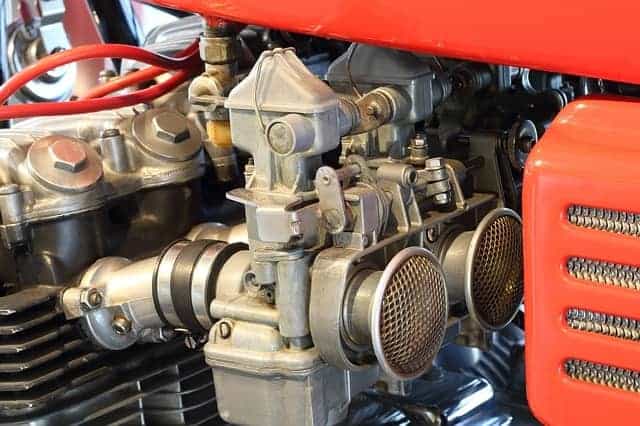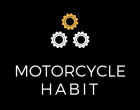Learning to ride a motorcycle is an exciting new adventure, but can seem a little overwhelming at first if you have never been around them. A motorcycle is a fairly simple system to operate and will become a lifelong hobby once you learn how to do it. In this article I will describe for you how a motorcycle works.
So, how does a motorcycle work? When the engine is running, the crankshaft inside the engine spins a sprocket. As this front sprocket spins, it turns a chain that is connected to a rear sprocket. The rear sprocket spins the rear wheel, which propels the motorcycle forward.
There is of course a lot of other little things going on inside the engine and transmission. As an engineer, I can describe in simple details how a motorcycle works.
Engine and Crankshaft
The crankshaft is near the bottom of motorcycle engines. The term rpm’s (rotations per minute) comes from measuring the amount of times the crankshaft makes a full revolution in one minute. So when you rev up your motorcycle and your rpm’s increase, it means your crankshaft is spinning faster.
The crankshaft gets spun by the motion of the pistons and connecting rods which are right above it in the engine. The pistons are moved up and down when fuel and air are combusted inside the cylinder. As the piston moves down it spins the crankshaft. As long as the engine is running, your crankshaft is spinning.
All internal combustion engines function pretty much the same, so if you can learn how a simple motorcycle engine works it helps you better understand the engine in your car. The one in your car is just a bit bigger.
The rotation of the crankshaft is what ultimately spins the rear wheel. But in order to be able to control the amount of power that is transferred to the rear wheel, every motorcycle has to have a clutch and several gears. The clutch is comprised of about 4 or 5 skinny discs that squeeze together and separate to transfer power from the crankshaft to the rear wheel.
Clutch
The clutch handle is usually the left handle on motorcycles. When you pull that lever it separates the clutch discs and allows you to select which gear you would like. Every time you change gears you have to pull the clutch lever. If not, you’ll ruin your transmission which is an expensive fix.
In order to get the motorcycle initially moving, you need to put it in first gear. This is done by pulling the clutch lever and pushing the gear lever down one click. The gear lever is usually by your left foot. You always know what gear you’re in by counting the clicks. If you want to go from first gear to second gear then click it up once.
Most motorcycles have 5 gears, so you simply click up on the gear lever when your rpm’s get high and you need to shift.
Transmission
The transmission of a motorcycle works the same way as a manual transmission in a car. You pull in the clutch, select your gear and then slowly let out the clutch while you give it some throttle so it doesn’t stall. The transmission is a series of gears that are different sizes, and those different sized gears determine how fast you can go.
You should always start in first gear on a motorcycle. Starting in any gear higher will cause it to stall and is bad for the clutch. Once your rpm’s get high in 1st gear then you pull in the clutch, shift to second gear and then slowly let out the clutch. Repeat this process for all gears.
Carburetors and Fuel Injectors

No article about how a motorcycle works is complete without having an understanding of how to start a motorcycle in the first place. In order for a motorcycle to start it needs fuel, air, and a spark. The fuel is squirted into the engine by one of two methods. Most older motorcycles use carburetors and most modern (2005 and up) motorcycles have fuel injection.
A carburetor gets its fuel supply from the fuel tank through one or two small hoses. The carburetor squirts a small amount of fuel and pushes air into the combustion chamber of the engine. The fuel and air are mixed and then the spark plug ignites the fuel/air into a small explosion in the combustion chamber. The combustion pushes the piston down and spins the crankshaft.
Fuel injection motorcycles are more reliable and easier to start in all temperature conditions. Carburetors have problems when they get really hot or really cold, but fuel injection doesn’t get affected by temperature swings, because a computer can control the fuel flow. Carbureted motorcycles don’t have a computer to control the fuel.
Fuel injection simply means that the fuel is pressurized and squirted more forcefully into the combustion chamber, whereas carburetors depend on engine suction power to pull the fuel and air in.
Motorcycles usually have between one and four cylinders. So this combustion sequence can be happening 4 times in a row very quickly, over and over again. So if someone says they have a four cylinder it means there are 4 combustion chambers and 4 pistons in their engine.
Starting From A Stand Still
All motorcycles are either electric start or kick start. An electric start motorcycle has a small button on one of the hand controls that will let send power to the start and turn over the engine, making it start. But a lot of older motorcycles and dirt bikes only have a kickstart. This is a lever on the right side of the motorcycle that connects by the right foot peg.
A kickstarter takes some practice to get used to. Put the motorcycle in neutral by clicking the gear lever all the way down and then up half of a click. You’ll know the motorcycle is in neutral if you’re able to roll the motorcycle forward and backward easily. Do not kickstart the motorcycle while it’s in gear. It can roll the motorcycle forward and make it tip over, I have seen people do it plenty of times.
For electric start motorcycles as well, always make sure you are in neutral when you start it. Some motorcycles will lurch forward when you hit the start button and you can crash into something. For safety reasons just make sure you always start the motorcycle in neutral.
The next thing to learn about is how to accelerate from a stand still. Once the motorcycle is started and in neutral you pull the clutch lever with your left hand and click the gear lever down once. You can feel the click if you get it right.
Once it is clicked into first gear you slowly let go of the clutch lever and slowly twist the throttle (your right handlebar). The key word is slowly. Don’t give it a lot of throttle or you risk doing a wheelie and losing control.
The balance of a motorcycle is the same as a bicycle. So if you don’t know how to ride a bicycle then don’t attempt to ride a motorcycle, you should learn how to ride a bicycle first to get used to balancing techniques. As you slowly accelerate, put both of your feet on the footpegs. Your right foot controls the rear brake and your right hand controls the front brake.
Things To Practice
Go slowly at first and just stay in first gear. Learn how to properly balance and practice things like stopping and starting, turning left and right, and using your hand controls like the horn and turn signals. Learn these simple things first before trying to go any faster. You’re bound to stall the motorcycle several times (or a lot of times) as you’re learning how to start and stop.
A very important thing to practice is steering. Steering on a motorcycle is two-fold. You must turn the handlebars like a normal bicycle but you also need to lean your weight into turns.
Trying to keep your body straight up while you turn is dangerous and can make you lose balance and wreck. Always lean with the motorcycle. It takes practice getting used to it. Find a big empty parking lot near your house and practice turning and maneuvers.
How To Brake And Stop Safely
As mentioned earlier there are two brakes on a motorcycle. Your right foot controls the rear brake and your right hand controls the front brake. When you want to slow down it’s very important that you apply equal pressure to both brakes. Braking with only one or the other is dangerous and can cause a crash.
Braking with only the front brake can cause you to go over the handlebars and lose control while only braking with the back brake can cause the rear tire to skid and make you go sideways.
Most modern motorcycles have disc brakes. Disc brakes are usually steel or ceramic circles, and when you pull the brake lever there is a little pad that squeezes on both sides of that disc and slows the motorcycle down.
Most older motorcycles have drum brakes. They work in a similar fashion but instead of squeezing in on a disc the pads push up and outwards onto the rotating wheel. These are not as effective.
Related Questions
Why is my motorcycle not starting? The most common reasons why a motorcycle isn’t starting are usually simple. Make sure it’s in neutral, check for blown fuses, make sure you have fuel, and make sure the key is turned on. See more in our article 13 reasons your motorcycle is not starting.
How does a motorcycle stator work? A stator is a wrapped up coil of wires with a spinning magnet in the middle of it. As the magnet spins it creates a magnetically induced charge in the coil, and that charge is sent to recharge the battery and power the systems of the motorcycle like the lights and horn. Click here to see our article to learn more about how a stator works.


